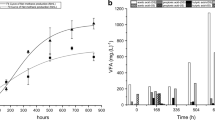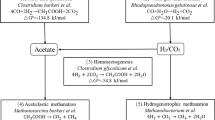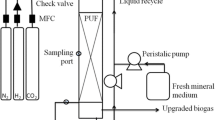Abstract
In fermentative hydrogen production, the low-hydrogen-producing bacteria retention rate limits the suspended growth reactor productivity because of the long hydraulic retention time (HRT) required to maintain adequate bacteria population. Traditional bacteria immobilization methods such as calcium alginate entrapment have many application limitations in hydrogen fermentation, including limited duration time, bacteria leakage, cost, and so on. The use of chloroform-treated anaerobic granular sludge as immobilized hydrogen-producing bacteria in an immobilized hydrogen culture may be able to overcome the limitations of traditional immobilization methods. This paper reports the findings on the performance of fed-batch cultures and continuous cultures inoculated with chloroform-treated granules. The chloroform-treated granules were able to be reused over four fed-batch cultures, with pH adjustment. The upflow reactor packed with chloroform-treated granules was studied, and the HRT of the upflow reactor was found to be as low as 4 h without any decrease in hydrogen production yield. Initial pH and glucose concentration of the culture medium significantly influenced the performance of the reactor. The optimum initial pH of the culture medium was neutral, and the optimum glucose concentration of the culture medium was below 20 g chemical oxygen demand/L at HRT 4 h. This study also investigated the possibility of integrating immobilized hydrogen fermentation using chloroform-treated granules with immobilized methane production using untreated granular sludge. The results showed that the integrated batch cultures produced 1.01 mol hydrogen and 2 mol methane per mol glucose. Treating the methanogenic granules with chloroform and then using the treated granules as immobilized hydrogen-producing sludge demonstrated advantages over other immobilization methods because the treated granules provide hydrogen-producing bacteria with a protective niche, a long duration of an active culture, and excellent settling velocity. This integrated two-stage design for immobilized hydrogen fermentation and methane production offers a promising approach for modifying current anaerobic wastewater treatment processes to harvest hydrogen from the existing systems.






Similar content being viewed by others
References
Levin, D. B., Pitt, L., & Love, M. (2004). International Journal of Hydrogen Energy, 29, 173–185.
Hu, B., Liu, Y.,Chi, Z., Chen, S. (2007). Biological Engineering (Accepted).
Kraemer, J. T., & Bagley, D. M. (2005). Environmental Science & Technology, 39, 3819–3825.
Kumar, N., & Das, D. (2001). International Journal of Hydrogen Energy, 26, 1155–1163.
Wu, S. Y., Lin, C. N., Chang, J. S., & Chang, J. S. (2005). International Journal of Hydrogen Energy, 30, 1375–1381.
Hu, B., & Chen, S. (2007). International Journal of Hydrogen Energy (in press).
Fang, H. H. P., Liu, H., & Zhang, T. (2002). Biotechnology and Bioengineering, 78, 44–52.
Chang, F. Y., & Lin, C. Y. (2004). International Journal of Hydrogen Energy, 29, 33–39.
Lee, K. S., Wu, J. F., Lo, Y. S., Lo, Y. C., Lin, P. J., & Chang, J. S. (2004). Biotechnology and Bioengineering, 87, 648–657.
Fang, H. H. P., Li, Y. Y., & Chui, H. K. (1995). Journal of Environmental Engineering-Asce, 121, 153–160.
Logan, B. E., Oh, S. E., Kim, I. S., & Van Ginkel, S. (2002). Environmental Science & Technology, 36, 2530–2535.
Pol, L. W. H., Lopes, S. I. D., Lettinga, G., & Lens, P. N. L. (2004). Water Research, 38, 1376–1389.
Macleod, F. A., Guiot, S. R., & Costerton, J. W. (1990). Applied and Environmental Microbiology, 56, 1598–1607.
Zheng, X. J., & Yu, H. Q. (2005). Journal of Environmental Management, 74, 65–70.
Nath, K., & Das, D. (2004). Applied Microbiology and Biotechnology, 65, 520–529.
Tan, T. W., Hu, B., & Su, H. J. (2004). Enzyme and Microbial Technology, 35, 508–513.
Van Ginkel, S. W., & Logan, B. (2005). Water Research, 39, 3819–3826.
Rachman, M. A., Furutani, Y., Nakashimada, Y., Kakizono, T., & Nishio, N. (1997). Journal of Fermentation and Bioengineering, 83, 358–363.
Oh, S. E., Lyer, P., Bruns, M. A., & Logan, B. E. (2004). Biotechnology and Bioengineering, 87, 119–127.
Mizuno, O., Dinsdale, R., Hawkes, F. R., Hawkes, D. L., & Noike, T. (2000). Bioresource Technology, 73, 59–65.
Yu, H. Q., & Mu, Y. (2006). Biotechnology and Bioengineering, 94, 988–995.
Wu, S. Y., Lin, C. N., & Chang, J. S. (2003). Biotechnology Progress, 19, 828–832.
Acknowledgments
Funding for this project was from the Washington State University Agricultural Research Center.
Author information
Authors and Affiliations
Corresponding author
Rights and permissions
About this article
Cite this article
Hu, B., Chen, S. Biological Hydrogen Production Using Chloroform-treated Methanogenic Granules. Appl Biochem Biotechnol 148, 83–95 (2008). https://doi.org/10.1007/s12010-007-8048-4
Received:
Accepted:
Published:
Issue Date:
DOI: https://doi.org/10.1007/s12010-007-8048-4




